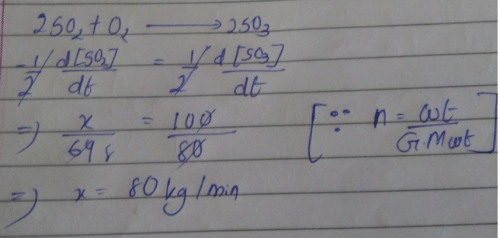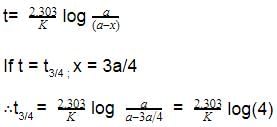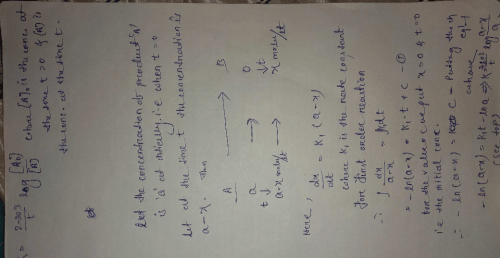All Exams >
NEET >
NCERT Based Tests for NEET >
All Questions
All questions of Chemical Kinetics for NEET Exam
Direction (Q. Nos. 14 and 15) This section contains a passage describing theory, experiments, data, etc. Two questions related to the paragraph have been given. Each question has only one correct answer out of the given 4 options (a), (b), (c) and (d)
Passage
The decomposition of NO2 at 400 K proceeds at a of rate of 5.4 x 10 -5 mol L-1 s-1 when [NO2] = 0.01 mol-1
2 NO2(g) → 2NO(g ) + O2(g).
Q. What is the rate law when observed rate is 1.35 x 10-5 mol L-1 s-1 at [NO2] = 0.005 mol L-1?
- a)k[NO2]
- b)k[NO2]0
- c)k[NO2]3
- d)k[NO2]2
Correct answer is option 'D'. Can you explain this answer?
Direction (Q. Nos. 14 and 15) This section contains a passage describing theory, experiments, data, etc. Two questions related to the paragraph have been given. Each question has only one correct answer out of the given 4 options (a), (b), (c) and (d)
Passage
The decomposition of NO2 at 400 K proceeds at a of rate of 5.4 x 10 -5 mol L-1 s-1 when [NO2] = 0.01 mol-1
2 NO2(g) → 2NO(g ) + O2(g).
Q. What is the rate law when observed rate is 1.35 x 10-5 mol L-1 s-1 at [NO2] = 0.005 mol L-1?
a)
k[NO2]
b)
k[NO2]0
c)
k[NO2]3
d)
k[NO2]2
|
|
Geetika Shah answered |
Given unit of rate = mol L-1 s-1
General formula for unit of rate = mol n-1 Ln-1 s -1
On equating,
1-n = 1 ⇒ n = 0
n-1 = -1 ⇒ n = 0
General formula for unit of rate = mol n-1 Ln-1 s -1
On equating,
1-n = 1 ⇒ n = 0
n-1 = -1 ⇒ n = 0
Hence, it is a zero order reaction.
The ratio of the rate constant of a reaction at two temperatures differing by __________0C is called temperature coefficient of reaction.- a)2
- b)10
- c)100
- d)50
Correct answer is option 'B'. Can you explain this answer?
The ratio of the rate constant of a reaction at two temperatures differing by __________0C is called temperature coefficient of reaction.
a)
2
b)
10
c)
100
d)
50

|
Devika Banerjee answered |
The ratio of the rate constant of a reaction at two temperatures differing by 100C is called temperature coefficient of reaction.
The initial rates of reaction for the equation, 2A + B → Products.Products were determined under various initial concentrations of reactants.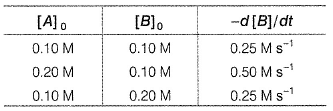 Thus, rate law is equal to
Thus, rate law is equal to- a)k[A][B]
- b)k[A][B]2
- c) k[A]
- d) k[B]
Correct answer is option 'C'. Can you explain this answer?
The initial rates of reaction for the equation, 2A + B → Products.
Products were determined under various initial concentrations of reactants.
Thus, rate law is equal to
a)
k[A][B]
b)
k[A][B]2
c)
k[A]
d)
k[B]
|
|
Ritu Singh answered |
Let order w.r.t. A = a, order w.r.t. B = b
The rate of a chemical reaction doubles for every 10°C rise of temperature. If the temperature is raised by 50°C, the rate of the reaction increases by about [AIEEE 2011]a)64 timesb)32 timesc)24 timesd)10 timesCorrect answer is option 'B'. Can you explain this answer?
|
|
Vijay Bansal answered |
Rate at 50 degree C/(Rate at T1 degree C)
= (2)^(ΔT/T1)
= (2)^(50/10)
= 2^5
= 32
Hence, the rate of the reaction increases by 32 times.
The effect of temperature on reaction rate is given by- a)Arrhenius equation
- b)Kirchoff’s Equation
- c)Clauius Claperyron equation
- d)Gibb’s Helmholtz equation
Correct answer is option 'A'. Can you explain this answer?
The effect of temperature on reaction rate is given by
a)
Arrhenius equation
b)
Kirchoff’s Equation
c)
Clauius Claperyron equation
d)
Gibb’s Helmholtz equation
|
|
T.ttttt answered |
Increasing the temperature increasesreaction rates because of the disproportionately large increase in the number of high energy collisions. It is only these collisions (possessing at least the activation energy for the reaction) which result in a reaction.
The reactions with low activation energy are- a)Slow
- b)Non-spontaneous
- c)Fast
- d)Always spontaneous
Correct answer is option 'C'. Can you explain this answer?
The reactions with low activation energy are
a)
Slow
b)
Non-spontaneous
c)
Fast
d)
Always spontaneous
|
|
Vivek Godara answered |
Low activation energy mean energy reguire for reaction to occur is low so product making is fast
A foreign substance that increase the speed of a chemical reaction is called- a)promotor
- b)catalyst
- c)moderator
- d)inhibitor
Correct answer is option 'B'. Can you explain this answer?
A foreign substance that increase the speed of a chemical reaction is called
a)
promotor
b)
catalyst
c)
moderator
d)
inhibitor
|
|
Nandini Patel answered |
Catalyst: Substances which alter the rate of a chemical reaction and themselves remain chemically and quantitatively unchanged after the reaction are known as catalysts and the phenomenon is known as catalysis.
If 75% of a first order reaction was completed in 32 min, then 50% of the reaction was completed in- a)24 min
- b)4 min
- c)16 min
- d)8 min
Correct answer is option 'C'. Can you explain this answer?
If 75% of a first order reaction was completed in 32 min, then 50% of the reaction was completed in
a)
24 min
b)
4 min
c)
16 min
d)
8 min

|
Avi Chawla answered |
75% completion means 2 half lifes so 50% completion means only one half life.
The rate law for a reaction between the substances A and 8 is given byrate = k[A]n [B]mIf concentration of A is doubled and that of 8 is halved, the new rate as compared to the earlier rate would be - a)

- b)(m + n)
- c)(n - m)
- d)2(n-m)
Correct answer is option 'D'. Can you explain this answer?
The rate law for a reaction between the substances A and 8 is given by
rate = k[A]n [B]m
If concentration of A is doubled and that of 8 is halved, the new rate as compared to the earlier rate would be
a)
b)
(m + n)
c)
(n - m)
d)
2(n-m)

|
Top Rankers answered |
The unit of rate constant for a first order reaction is- a)Mol/L
- b)Mol2 / L2 / S2
- c)S-1
- d)Mol/L/S
Correct answer is option 'C'. Can you explain this answer?
The unit of rate constant for a first order reaction is
a)
Mol/L
b)
Mol2 / L2 / S2
c)
S-1
d)
Mol/L/S
|
|
Nikita Singh answered |
The correct answer is Option C.
Let R be the rate of reaction.
For first order reaction,
R=K[A]1
⇒K=R[A]-1
Whereas, K and [A] are rate constant and initial concentration of reactant respectively.
Therefore,
Unit of rate constant =(mol L-1)1-nsec-1
For first order reaction, n=1
Unit of rate constant = sec-1
Hence the unit of rate constant for first order reaction is sec-1.
For first order reaction,
R=K[A]1
⇒K=R[A]-1
Whereas, K and [A] are rate constant and initial concentration of reactant respectively.
Therefore,
Unit of rate constant =(mol L-1)1-nsec-1
For first order reaction, n=1
Unit of rate constant = sec-1
Hence the unit of rate constant for first order reaction is sec-1.
The rate is independent of the concentration of the reactants in- a)First order
- b)Second order
- c)Third order
- d)Zero order
Correct answer is option 'D'. Can you explain this answer?
The rate is independent of the concentration of the reactants in
a)
First order
b)
Second order
c)
Third order
d)
Zero order
|
|
Naiham Difoesa answered |
Bcz rate is proportional to the zeroth power of the concentration of reactant.
Direction (Q. Nos. 1-13) This section contains multiple choice questions. Each question has four choices (a), (b), (c) and (d), out of which ONLY ONE is correctQ. In the following reaction, which has maximum rate w.r.t. rate of disappearance of NH3?4NH3 + 502 → 4NO + 6H2O- a)O2
- b)NO
- c)H2O
- d)Equal
Correct answer is option 'C'. Can you explain this answer?
Direction (Q. Nos. 1-13) This section contains multiple choice questions. Each question has four choices (a), (b), (c) and (d), out of which ONLY ONE is correct
Q. In the following reaction, which has maximum rate w.r.t. rate of disappearance of NH3?
4NH3 + 502 → 4NO + 6H2O
a)
O2
b)
NO
c)
H2O
d)
Equal

|
Nabanita Basu answered |
Understanding the Reaction
The given reaction is:
4NH3 + 5O2 → 4NO + 6H2O
This reaction involves the disappearance of ammonia (NH3) and the appearance of the products NO and H2O.
Rate of Reaction
The rate of a chemical reaction can be expressed in terms of the rate of disappearance of reactants or the rate of appearance of products.
Stoichiometry of the Reaction
- According to the stoichiometry:
- 4 moles of NH3 produce 4 moles of NO and 6 moles of H2O.
- The coefficients in the balanced equation indicate the relative rates of disappearance and appearance.
Rate of Disappearance
- The rate of disappearance of NH3 is given by:
Rate = - (1/4) * d[NH3]/dt
- The rates for O2, NO, and H2O can be expressed similarly:
- O2: Rate = - (1/5) * d[O2]/dt
- NO: Rate = (1/4) * d[NO]/dt
- H2O: Rate = (1/6) * d[H2O]/dt
Comparison of Rates
To find the maximum rate of disappearance, we can compare the rates derived from the balanced equation:
- NH3: - (1/4) (for every 1 mole of disappearance)
- O2: - (1/5) (for every 1 mole of disappearance)
- NO: (1/4) (for every 1 mole of appearance)
- H2O: (1/6) (for every 1 mole of appearance)
The fractions reveal how many moles of each substance are involved in the reaction. The lower the denominator, the higher the rate of disappearance or appearance.
Conclusion
- Among the reactants and products, H2O has the highest coefficient when considering the rate of disappearance of NH3.
- Therefore, the maximum rate of disappearance is related to H2O's formation.
Thus, the correct answer is option 'C' (H2O).
The given reaction is:
4NH3 + 5O2 → 4NO + 6H2O
This reaction involves the disappearance of ammonia (NH3) and the appearance of the products NO and H2O.
Rate of Reaction
The rate of a chemical reaction can be expressed in terms of the rate of disappearance of reactants or the rate of appearance of products.
Stoichiometry of the Reaction
- According to the stoichiometry:
- 4 moles of NH3 produce 4 moles of NO and 6 moles of H2O.
- The coefficients in the balanced equation indicate the relative rates of disappearance and appearance.
Rate of Disappearance
- The rate of disappearance of NH3 is given by:
Rate = - (1/4) * d[NH3]/dt
- The rates for O2, NO, and H2O can be expressed similarly:
- O2: Rate = - (1/5) * d[O2]/dt
- NO: Rate = (1/4) * d[NO]/dt
- H2O: Rate = (1/6) * d[H2O]/dt
Comparison of Rates
To find the maximum rate of disappearance, we can compare the rates derived from the balanced equation:
- NH3: - (1/4) (for every 1 mole of disappearance)
- O2: - (1/5) (for every 1 mole of disappearance)
- NO: (1/4) (for every 1 mole of appearance)
- H2O: (1/6) (for every 1 mole of appearance)
The fractions reveal how many moles of each substance are involved in the reaction. The lower the denominator, the higher the rate of disappearance or appearance.
Conclusion
- Among the reactants and products, H2O has the highest coefficient when considering the rate of disappearance of NH3.
- Therefore, the maximum rate of disappearance is related to H2O's formation.
Thus, the correct answer is option 'C' (H2O).
Reaction kinetics deals with the study of- a)Rate of reaction
- b)Mechanism of reaction
- c)Factors which affects the rate of reaction
- d)All of the mentioned
Correct answer is option 'D'. Can you explain this answer?
Reaction kinetics deals with the study of
a)
Rate of reaction
b)
Mechanism of reaction
c)
Factors which affects the rate of reaction
d)
All of the mentioned
|
|
Om Desai answered |
Reaction kinetics deals with the study of rate of reaction, their mechanism and the factors which affects the rate of reaction. It specifies all the general characteristics of a chemical reaction.
A Certain Zeroth Order reaction has k = 0.025 Ms-1 for the disappearance of A. What will be the concentration of A after 15s, if the intial concentration is 0.50 M?- a)0.50 M
- b)0.375 M
- c)0.125 M
- d)0.060 M
Correct answer is option 'C'. Can you explain this answer?
A Certain Zeroth Order reaction has k = 0.025 Ms-1 for the disappearance of A. What will be the concentration of A after 15s, if the intial concentration is 0.50 M?
a)
0.50 M
b)
0.375 M
c)
0.125 M
d)
0.060 M

|
Sinjini Tiwari answered |
x (product) formed after 15 s = 0.025 Ms-1 x 15s= 0.375 M Then, reactant left = 0.500 - 0.375= 0.125 M
Direction (Q. Nos. 1-13) This section contains multiple choice questions. Each question has four choices (a), (b), (c) and (d), out of which ONLY ONE is correctQ. In the following reaction, which has maximum rate w.r.t. rate of disappearance of NH3?4NH3 + 502 → 4NO + 6H2O- a)O2
- b)NO
- c)H2O
- d)Equal
Correct answer is 'C'. Can you explain this answer?
Direction (Q. Nos. 1-13) This section contains multiple choice questions. Each question has four choices (a), (b), (c) and (d), out of which ONLY ONE is correct
Q. In the following reaction, which has maximum rate w.r.t. rate of disappearance of NH3?
4NH3 + 502 → 4NO + 6H2O
a)
O2
b)
NO
c)
H2O
d)
Equal
|
|
Manoj Chauhan answered |
By stoichiometry of the reaction

similarly,

Study of rate of chemical reaction is known as- a)Chemical thermodynamics
- b)Chemical kinetics
- c)Chemical equilibrium
- d)Chemical change
Correct answer is option 'B'. Can you explain this answer?
Study of rate of chemical reaction is known as
a)
Chemical thermodynamics
b)
Chemical kinetics
c)
Chemical equilibrium
d)
Chemical change

|
Sarthak Khanna answered |
Chemical Kinetics deals with rate of a Chemical reactions.
Two reactions with different activation energies have the same rate at room temperature. Which statement correctly describes the rates of these two reactions at the same higher temperature?- a)The reaction with the greater activation energy will be faster
- b)The reaction with the smaller activation energy will be faster
- c)The two reactions will have the same rate at higher temperature also
- d)Temperature range is also required
Correct answer is option 'B'. Can you explain this answer?
Two reactions with different activation energies have the same rate at room temperature. Which statement correctly describes the rates of these two reactions at the same higher temperature?
a)
The reaction with the greater activation energy will be faster
b)
The reaction with the smaller activation energy will be faster
c)
The two reactions will have the same rate at higher temperature also
d)
Temperature range is also required

|
Pranjal Pillai answered |


If temperature is increased to T`,
If 
Thus, reaction with smaller activation energy will be faster on increasing temperature.

Thus, reaction with smaller activation energy will be faster on increasing temperature.
For the reaction, 
 Mechanism is given by
Mechanism is given by Rate law is true, if
Rate law is true, if - a)step I is the slow step
- b)step II is the slow step
- c)step III is the slow step
- d)step I and step II are the slow steps
Correct answer is option 'B'. Can you explain this answer?
For the reaction, 
Mechanism is given by
Rate law is true, if
a)
step I is the slow step
b)
step II is the slow step
c)
step III is the slow step
d)
step I and step II are the slow steps

|
Thedot Starry answered |
Yes b is correct because the rate law is written using the slowest step and it matches with second option.
Decomposition of H2O2 was studied by titration against KMnO4 solution. It was found that 0.4 mol of H2O2 was reduced to 0.2 mol in 20 min and to 0.1 mol in 40 min and to 0.05 mol after 1 hr, the order of reaction must be- a)3
- b)1
- c)0
- d)2
Correct answer is option 'B'. Can you explain this answer?
Decomposition of H2O2 was studied by titration against KMnO4 solution. It was found that 0.4 mol of H2O2 was reduced to 0.2 mol in 20 min and to 0.1 mol in 40 min and to 0.05 mol after 1 hr, the order of reaction must be
a)
3
b)
1
c)
0
d)
2

|
Om Kumar answered |
Decomposition of nH2O2 is 1st order.
If a reaction proceeds with a uniform rate throughout, the reaction is- a)Third order
- b)Second order
- c)First order
- d)Zero order
Correct answer is option 'D'. Can you explain this answer?
If a reaction proceeds with a uniform rate throughout, the reaction is
a)
Third order
b)
Second order
c)
First order
d)
Zero order
|
|
Rohan Singh answered |
A reaction with uniform rate means dC/dt is a constant, where C is the concentration of the reactant being consumed.
For an n-th order reaction,
dC/dt = kC^n
As dC/dt is independent of C
dC/dt = k C^0
Thus, n = 0, and the reaction is a zero order reaction.
Which among the following is an example of first order reaction?- a)Acid catalysed hydrolysis of ethyl acetate
- b)Formation and dissociation of ozone
- c)Inversion of cane sugar
- d)Decomposition of nitrogen pentoxide
Correct answer is option 'D'. Can you explain this answer?
Which among the following is an example of first order reaction?
a)
Acid catalysed hydrolysis of ethyl acetate
b)
Formation and dissociation of ozone
c)
Inversion of cane sugar
d)
Decomposition of nitrogen pentoxide

|
Sayan Ghosh answered |
But what is the order of inversion of Cane sugar reaction?
. What will be the value of instantaneous rate of reaction from the graph?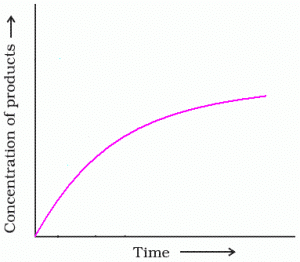
- a)rinst = 1/ Slope
- b)rinst = Slope
- c)rinst = – Slope
- d)rinst = – 1/ Slope
Correct answer is option 'B'. Can you explain this answer?
. What will be the value of instantaneous rate of reaction from the graph?

a)
rinst = 1/ Slope
b)
rinst = Slope
c)
rinst = – Slope
d)
rinst = – 1/ Slope
|
|
Preeti Iyer answered |
If you make a graph of concentration of reactant vs time, the instantaneous reaction rate at a given time is the slope of the tangent line at that point in time. It is also the value of the rate law at a specific concentration (dA/dt is rate = k [A]).
The activation energies of two reactions are given as Ea1= 40 J and Ea2= 80 J, then the relation between their rate constants can be written as:- a)k1 > k2
- b)k1 < k2
- c)k1 = k2
- d)k1 + k2 = 0
Correct answer is option 'A'. Can you explain this answer?
The activation energies of two reactions are given as Ea1= 40 J and Ea2= 80 J, then the relation between their rate constants can be written as:
a)
k1 > k2
b)
k1 < k2
c)
k1 = k2
d)
k1 + k2 = 0
|
|
Vijay Bansal answered |
As the value of activation energy, Ea increases, the value of rate constant, k decreases.
So, k1 > k2 since E1 < E2
For the first order reaction,A → ProductQ. The concentration of A changes from 0.1 M to 0.025 M in 40 min. The rate of the reaction when the concentration of A is 0.01 M is[AIEEE 2012]- a)1.73 x 10-6 Mmin-1
- b)3.47 x 10-4 M min-1
- c)3.47 x 10-5 M min-1
- d)1.73 x 10-6 M min-1
Correct answer is option 'B'. Can you explain this answer?
For the first order reaction,
A → Product
Q. The concentration of A changes from 0.1 M to 0.025 M in 40 min. The rate of the reaction when the concentration of A is 0.01 M is
[AIEEE 2012]
a)
1.73 x 10-6 Mmin-1
b)
3.47 x 10-4 M min-1
c)
3.47 x 10-5 M min-1
d)
1.73 x 10-6 M min-1

|
Sanjana Bajaj answered |
A first-order reaction is a type of chemical reaction where the rate of reaction is directly proportional to the concentration of one reactant. The rate equation for a first-order reaction can be written as follows:
rate = k[A]
Where:
- rate is the rate of reaction
- k is the rate constant
- [A] is the concentration of reactant A
This means that as the concentration of reactant A decreases, the rate of reaction also decreases. The half-life of a first-order reaction is constant, meaning that it takes the same amount of time for the concentration of reactant A to decrease by half, regardless of the initial concentration.
rate = k[A]
Where:
- rate is the rate of reaction
- k is the rate constant
- [A] is the concentration of reactant A
This means that as the concentration of reactant A decreases, the rate of reaction also decreases. The half-life of a first-order reaction is constant, meaning that it takes the same amount of time for the concentration of reactant A to decrease by half, regardless of the initial concentration.
For the reaction, The half-life period was independent of concentration of B. On doubling the concentration A, rate increases two times. Thus, unit of rate constant for this reaction is
The half-life period was independent of concentration of B. On doubling the concentration A, rate increases two times. Thus, unit of rate constant for this reaction is- a)L mol-1s-1
- b)mol L-1s-1
- c)unitless
- d)S-1
Correct answer is option 'A'. Can you explain this answer?
For the reaction,
The half-life period was independent of concentration of B. On doubling the concentration A, rate increases two times. Thus, unit of rate constant for this reaction is
a)
L mol-1s-1
b)
mol L-1s-1
c)
unitless
d)
S-1
|
|
Shanaya Choudhary answered |
I apologize, but your question about the reaction is incomplete. Could you provide more information or detail about the reaction you are referring to?
The rate equation for the reaction,2A + B → Cis found to be, rate = k[A] [B]Q. The correct statement in relation to this reaction is that the- a)unit of k must be s-1
- b)t1/2 is constant
- c)rate of formation of C is half of the rate of disappearance of A
- d)value of k is independent of the initial concentration of A and 8
Correct answer is option 'C'. Can you explain this answer?
The rate equation for the reaction,
2A + B → C
is found to be, rate = k[A] [B]
Q. The correct statement in relation to this reaction is that the
a)
unit of k must be s-1
b)
t1/2 is constant
c)
rate of formation of C is half of the rate of disappearance of A
d)
value of k is independent of the initial concentration of A and 8

|
Amar Jain answered |
Rate = k (A)[B]
The given reaction is first order in A and first order is B.
Thus, total order = 2
Thus, total order = 2
(a) Unit of k = cone 1 - n time -1 = conc-1 time-1 Thus, (a) is false.
(b) of second-order reaction, thus (b) is false.
of second-order reaction, thus (b) is false.

(b)
Thus, (c) is correct.

Thus, value of k is dependent on the concentration of A and B. Thus, (d) is false.
Thus, value of k is dependent on the concentration of A and B. Thus, (d) is false.
A first order reaction is 50% completed in 1.26 × 1014 s. How much time would it take for 100% completion?- a)1.26 × 1015 s
- b)2.52 × 1014 s
- c)2.52 × 1028 s
- d) infinite
Correct answer is option 'D'. Can you explain this answer?
A first order reaction is 50% completed in 1.26 × 1014 s. How much time would it take for 100% completion?
a)
1.26 × 1015 s
b)
2.52 × 1014 s
c)
2.52 × 1028 s
d)
infinite
|
|
Neha Chauhan answered |
The time taken for half the reaction to complete, i.e., the time in which the concentration of a reactant is reduced to half of its original value is called half-life period of the reaction. But it is impossible to perform 100% of the reaction. Whole of the substance never reacts because in every half-life, 50% of the substance reacts. Hence, time taken for 100% completion of a reaction is infinite.
Which among the following statement is not true for rate constant of a reaction?- a)Rate constant depend upon the concentration of the reactants
- b)Unit of rate constant depend upon the order of reaction
- c)Rate constant has a definite value at a particular temperature
- d)Rate constant changes with temperature
Correct answer is option 'A'. Can you explain this answer?
Which among the following statement is not true for rate constant of a reaction?
a)
Rate constant depend upon the concentration of the reactants
b)
Unit of rate constant depend upon the order of reaction
c)
Rate constant has a definite value at a particular temperature
d)
Rate constant changes with temperature

|
Anjana Sen answered |
Rate constant is independent of concentration of reactant.
Chapter doubts & questions for Chemical Kinetics - NCERT Based Tests for NEET 2025 is part of NEET exam preparation. The chapters have been prepared according to the NEET exam syllabus. The Chapter doubts & questions, notes, tests & MCQs are made for NEET 2025 Exam. Find important definitions, questions, notes, meanings, examples, exercises, MCQs and online tests here.
Chapter doubts & questions of Chemical Kinetics - NCERT Based Tests for NEET in English & Hindi are available as part of NEET exam.
Download more important topics, notes, lectures and mock test series for NEET Exam by signing up for free.
NCERT Based Tests for NEET
684 tests
|






